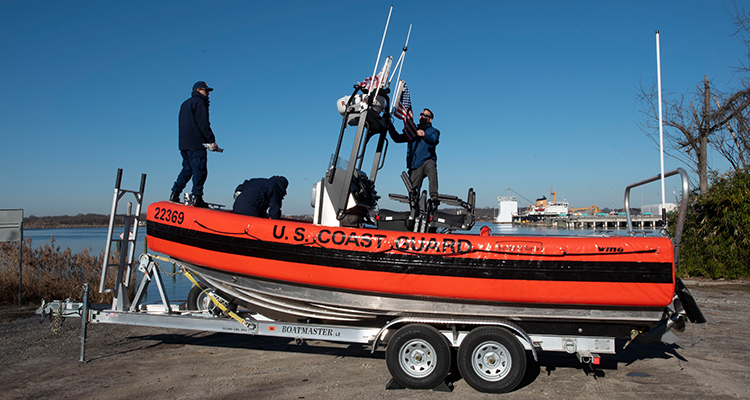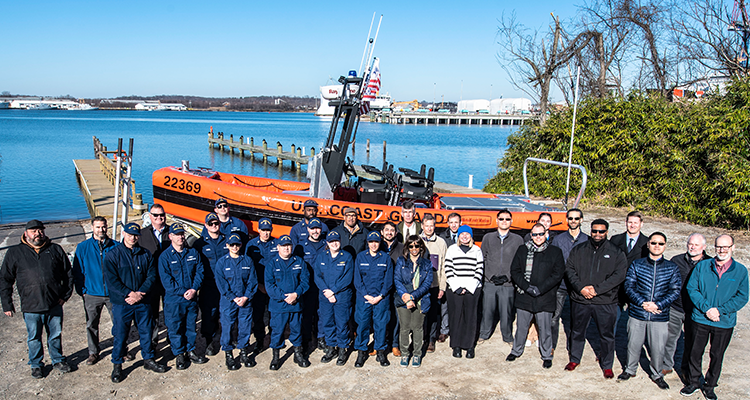Feb. 12, 2024 —

Workers at Coast Guard Yard put the finishing touches on the cutter boat-large delivered to Coast Guard Cutter Sequoia on Feb. 5, 2024. U.S. Coast Guard photo by Petty Officer 2nd Class Ronald Hodges.
The Coast Guard Boat Acquisition Program delivered its 39th and final cutter boat-large (CB-L) on Feb. 5, 2024, completing replacement of the aging fleet of legacy cutter boats that previously operated with the Coast Guard’s 210-foot cutters, 225-foot buoy tenders, and Coast Guard Cutters Alex Haley and Mackinaw. This CB-L went to Coast Guard Cutter Sequoia, which is currently undergoing work at Coast Guard Yard in Baltimore.
This delivery marks a key milestone for the Boat Acquisition Program, which overseas acquisition programs to deliver upgraded, modernized response boats, cutter boats, aids to navigation boats and special purpose craft to meet Coast Guard mission needs. The Coast Guard’s multiple cutter boats, including the CB-Ls, provide varied levels of capability aligned to interface with the parent cutters’ configuration and mission profile.

Coast Guard Yard personnel and crew members of Coast Guard Cutter Sequoia with the final CB-L delivered through the Boat Acquisition Program. U.S. Coast Guard photo by Petty Officer 2nd Class Ronald Hodges.
Cutter boats provide the critical final link in mission execution for the cutter fleet. They allow the deployment or transfer of personnel and equipment when the operations cannot be performed directly from the cutter. A typical service life for a cutter exceeds 25 years, while the service life for a cutter boat ranges from seven to 10 years, requiring replacement of the cutter boat once or twice during the expected service life of the cutter. Each time the cutter boat is replaced, the program works to take advantage of state-of-the-market advances and incorporate improvements into the new generation of boats. This typically results in more capable cutter boats that provide increased or enhanced mission capability for the parent cutters.
The Boat Acquisition Program is divided into two major categories: cutter boats and shore-based boats.
In the cutter boats category, the Coast Guard is acquiring the over the horizon (OTH) generations IV and V and the long range interceptor (LRI) generation III, in addition to the just-completed acquisition of the CB-L.
The OTH IV is slightly larger than its predecessor and features improved endurance, upgraded electronics, enhanced shock mitigation seating and other human factors engineering enhancements for the crew. The OTH V will replace the OTH IVs as they reach the end of their service life and provide OTH capability for a broader range of cutters, expanding to the offshore patrol cutter and polar security cutter.
The LRI provides capability similar to the OTH with greatly improved carrying capacity and improved protection for crews. The LRI is deployed on national security cutters (NSCs) using the stern notch on the NSC for launch and recovery. The Coast Guard has awarded a contract for the third-generation LRI to replace the LRI II as it reaches the end of its service life.
The 22-foot CB-L is a high-speed, maneuverable boat primarily focused on law enforcement support for the 225-foot seagoing buoy tender and a complement to the OTH capability of the 210-foot medium endurance cutter fleet. Although the CB-L lacks the enhanced passenger capacity and long-range communication of the OTH IV, it is equipped with a similar high-speed capability and crew accommodation. The CB-L's design allows for full interoperability among four classes of cutters without the need for variants or modifications.
In the shore-based boats category, the Coast Guard is conducting a service life extension program (SLEP) for the 47-foot motor lifeboat (MLB) to extend the useful life of the MLB fleet by 20 years through 2047. The SLEP timeline remains on schedule to place up to 107 MLBs back to full operational capability prior to 2030.
Initiation of an acquisition program for the replacement of aids to navigation boats is anticipated in 2024.
For more information: Boat Acquisition Program page.